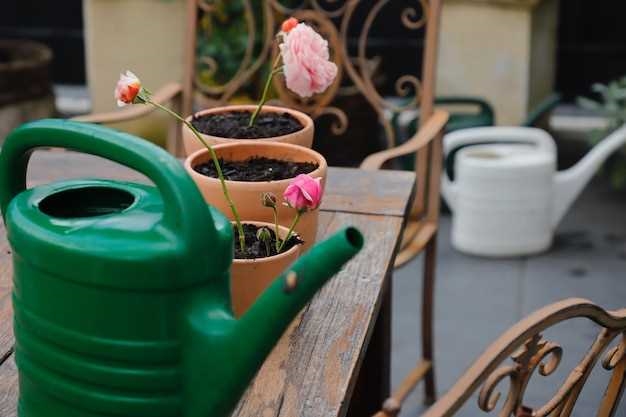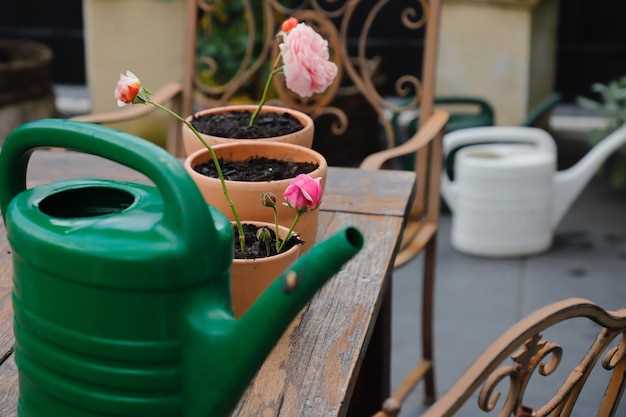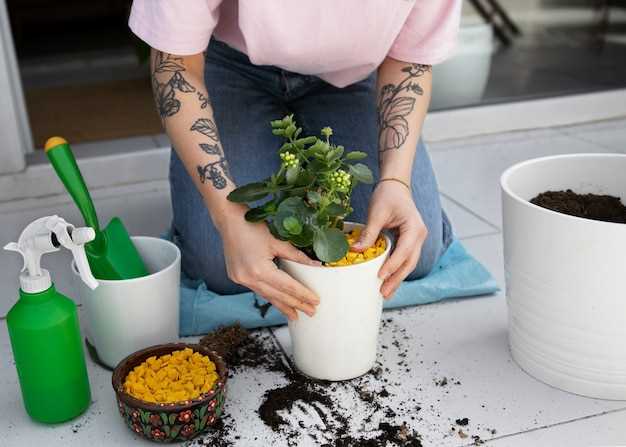

In the realm of sustainable cultivation, there exists an indispensable tool that plays a pivotal role in nurturing plants while simultaneously promoting environmental consciousness. This essential instrument, commonly known as a watering vessel, serves as a conduit for the vital element of life – water. By harnessing the power of this simple yet effective device, gardeners can actively contribute to the preservation of our planet’s precious resources and actively combat the detrimental effects of wasteful practices.
Within the realm of eco-friendly gardening, the utilization of watering vessels serves as a catalyst for water conservation, enabling individuals to exercise responsible stewardship over this finite resource. These vessels, often crafted from durable materials such as metal or recycled plastic, possess the capacity to hold and distribute water in a controlled manner, ensuring that each droplet is utilized efficiently and effectively. Through the implementation of strategic watering techniques, gardeners can minimize water waste and optimize the nourishment of their plants, fostering a harmonious relationship between cultivation and conservation.
Moreover, the significance of watering vessels extends beyond the realm of water conservation, encompassing the broader objective of waste reduction. In traditional gardening practices, the use of indiscriminate watering methods, such as sprinklers or hoses, often leads to excessive runoff and unnecessary water loss. This wasteful approach not only depletes our limited water supply but also contributes to the accumulation of harmful pollutants in our ecosystems. By employing watering vessels, gardeners can exercise greater control over the distribution of water, minimizing runoff and preventing the unnecessary contamination of our soil and water sources.
The Importance of Watering Cans in Sustainable Gardening
Watering cans play a crucial role in promoting environmentally-friendly practices in the realm of cultivating plants and flowers. These essential tools contribute significantly to the preservation of our natural resources and the reduction of waste. By utilizing watering cans, gardeners can effectively manage water usage, conserve this precious resource, and minimize unnecessary water loss.
Efficient Water Distribution: Watering cans offer a practical and efficient method for distributing water to plants. With their controlled pouring spouts, gardeners can precisely target the base of plants, ensuring that water reaches the roots where it is most needed. This targeted approach minimizes water runoff and evaporation, maximizing the effectiveness of each watering session.
Reduced Water Waste: Unlike other watering methods, such as sprinklers or hoses, watering cans allow gardeners to avoid water waste. By directly applying water to the soil around plants, watering cans prevent excess water from being lost to evaporation or runoff. This not only conserves water but also reduces the need for additional watering, ultimately saving both time and resources.
Enhanced Plant Health: The controlled and gentle flow of water from a watering can promotes healthier plant growth. By avoiding excessive force or pressure, watering cans prevent soil erosion and damage to delicate plants. This nurturing approach helps plants establish strong root systems and thrive, leading to more sustainable and resilient gardens.
Connection to Nature: Using a watering can fosters a deeper connection between gardeners and the natural world. The act of manually watering plants allows individuals to observe and interact with their garden more intimately. This connection promotes a greater understanding of the needs of plants and encourages responsible water usage, ultimately contributing to a more sustainable gardening practice.
In conclusion, watering cans are indispensable tools in sustainable gardening, offering efficient water distribution, reduced water waste, enhanced plant health, and a deeper connection to nature. By incorporating watering cans into our gardening routines, we can actively contribute to water conservation efforts and promote a more environmentally-conscious approach to cultivating our green spaces.
Watering Cans: A Tool for Efficient Watering
Watering cans play a crucial role in promoting efficient irrigation practices and optimizing water usage in the realm of sustainable gardening. These practical tools offer a means to distribute water precisely and effectively, ensuring that plants receive the necessary hydration without excessive waste or runoff. By utilizing watering cans, gardeners can contribute to water conservation efforts and minimize the environmental impact associated with traditional watering methods.
One of the key advantages of using watering cans is their ability to provide targeted watering. Unlike other irrigation systems, which may result in water being dispersed over a wide area, watering cans allow gardeners to direct water precisely to the base of plants. This targeted approach ensures that water reaches the roots where it is needed most, reducing the risk of evaporation and runoff. By avoiding unnecessary water loss, gardeners can conserve water resources and promote sustainable gardening practices.
Furthermore, watering cans enable gardeners to control the amount of water being applied to plants. With their capacity to hold a specific volume of water, these tools allow for measured watering, preventing overwatering and water wastage. By carefully monitoring the amount of water used, gardeners can prevent waterlogged soil, root rot, and other issues associated with excessive irrigation. This not only conserves water but also promotes healthier plant growth and reduces the need for additional resources such as fertilizers and pesticides.
In addition to their practical benefits, watering cans also offer a cost-effective solution for gardeners. Compared to automated irrigation systems or hosepipes, watering cans are relatively inexpensive and require minimal maintenance. They are a versatile tool that can be used in various garden sizes and layouts, making them accessible to both professional gardeners and hobbyists. By investing in a high-quality watering can, gardeners can achieve efficient watering while minimizing their ecological footprint.
| Benefits of Watering Cans: |
|---|
| 1. Precise and targeted watering |
| 2. Control over water volume |
| 3. Water conservation |
| 4. Cost-effective |
In conclusion, watering cans serve as an essential tool for efficient watering in sustainable gardening practices. Their ability to provide targeted watering, control water volume, and promote water conservation makes them an invaluable asset for gardeners striving to reduce water waste and minimize their environmental impact. By incorporating watering cans into their gardening routines, individuals can contribute to a more sustainable future while nurturing healthy and thriving plants.
How Watering Cans Aid in Preserving Water in Horticulture
Watering cans play a crucial role in the conservation of water resources within the realm of gardening. By utilizing these practical tools, gardeners can effectively manage and distribute water to their plants, ensuring minimal wastage and maximum efficiency. Watering cans serve as a sustainable solution for maintaining plant health while minimizing water consumption.
One of the primary benefits of using watering cans is their ability to provide targeted watering. Unlike other irrigation methods, such as sprinklers or hoses, watering cans allow gardeners to direct water precisely where it is needed most. This targeted approach ensures that plants receive adequate hydration without excess water being wasted on non-essential areas.
Additionally, watering cans enable gardeners to control the flow rate of water. By adjusting the spout or nozzle, individuals can regulate the amount of water released, preventing overwatering and reducing water runoff. This level of control not only conserves water but also minimizes the risk of soil erosion and nutrient leaching.
Watering cans also promote water conservation through their capacity to collect and reuse rainwater. By capturing rainwater in large containers or barrels, gardeners can then transfer it into watering cans for use in their gardens. This practice not only reduces reliance on freshwater sources but also minimizes the strain on municipal water supplies.
Furthermore, the use of watering cans encourages a mindful approach to gardening, fostering a deeper connection between gardeners and their plants. By taking the time to water each plant individually, gardeners develop a greater understanding of their plants’ needs, allowing them to adjust their watering practices accordingly. This attentiveness leads to more efficient water usage and healthier, thriving plants.
- Targeted watering
- Controlled flow rate
- Rainwater collection and reuse
- Mindful gardening practices
In conclusion, watering cans serve as valuable tools in sustainable gardening by aiding in water conservation efforts. Through targeted watering, controlled flow rates, rainwater collection, and promoting mindful gardening practices, these simple yet effective devices contribute to the preservation of water resources and the overall sustainability of gardening practices.
Reducing Water Waste with the Use of Watering Cans
Efficient water usage is a crucial aspect of sustainable gardening practices. By employing watering cans as a means of irrigation, gardeners can significantly reduce water waste and promote environmental conservation. The utilization of watering cans allows for precise and targeted watering, ensuring that plants receive the necessary amount of water without excess runoff or evaporation.
Preserving Water Resources
Water scarcity is a global concern, and it is essential to adopt methods that minimize water wastage in gardening. Watering cans offer a practical solution by enabling gardeners to control the amount of water used. Unlike other irrigation methods, such as sprinklers or hoses, watering cans allow for a more measured approach, ensuring that water is directed precisely where it is needed most. This targeted watering reduces the risk of overwatering and runoff, ultimately conserving water resources.
Preventing Soil Erosion and Nutrient Loss
Excessive watering can lead to soil erosion and nutrient leaching, negatively impacting plant growth and overall soil health. Watering cans provide gardeners with the ability to water plants gently and evenly, preventing soil erosion and the loss of essential nutrients. By avoiding excessive water application, gardeners can maintain a healthy soil structure and preserve the integrity of their garden ecosystem.
In conclusion, the use of watering cans in gardening plays a vital role in reducing water waste and promoting sustainable practices. By employing this precise and controlled method of irrigation, gardeners can contribute to water conservation efforts, prevent soil erosion, and maintain the overall health of their gardens.
Choosing the Right Watering Can for Sustainable Gardening
Optimizing your watering practices is essential for maintaining a sustainable garden. One of the key elements in achieving this is selecting the appropriate watering can. By carefully choosing a watering can that aligns with your gardening needs and environmental goals, you can contribute to water conservation and waste reduction without compromising the health and vitality of your plants.
Consider the Size and Capacity
When choosing a watering can, it’s important to consider its size and capacity. A larger watering can may be suitable for gardens with extensive plantings, while a smaller one may be more appropriate for smaller spaces or indoor plants. By selecting a watering can that matches the scale of your garden, you can ensure efficient water usage and minimize wastage.
Look for Efficient Design Features
Efficiency is a crucial factor to consider when selecting a watering can for sustainable gardening. Look for features such as a narrow spout or a rose attachment that allows for precise watering, minimizing water runoff and ensuring that water reaches the roots where it’s needed most. Additionally, consider a watering can with a comfortable handle and balanced weight distribution to make watering tasks easier and more enjoyable.
By choosing a watering can with efficient design features, you can reduce water waste and promote the overall sustainability of your garden.
Remember, the right watering can is a valuable tool in your sustainable gardening journey. By considering the size and capacity, as well as efficient design features, you can make a positive impact on water conservation and waste reduction while nurturing your plants and creating a thriving garden environment.
Tips for Maximizing Water Efficiency with Watering Cans
Enhancing the effectiveness of watering cans is crucial for optimizing water usage in sustainable gardening practices. By implementing these practical tips, gardeners can ensure maximum water efficiency without compromising the health and vitality of their plants.
1. Strategize your watering schedule
Developing a well-thought-out watering schedule is essential for minimizing water waste. Consider the specific needs of your plants and create a routine that aligns with their requirements. By watering during the cooler parts of the day, such as early morning or late evening, you can reduce evaporation and ensure that the water reaches the roots where it is needed most.
2. Use the right watering technique

Mastering the art of proper watering techniques can significantly enhance water efficiency. Instead of drenching the entire plant, focus on delivering water directly to the root zone. This targeted approach ensures that the plants receive the necessary moisture while minimizing runoff and evaporation. Additionally, using a gentle and steady flow from the watering can helps prevent soil erosion and allows for better absorption.
Furthermore, consider using a rose attachment on the watering can’s spout. This attachment disperses water in a fine spray, reducing the force of the water and preventing damage to delicate seedlings or young plants.
3. Collect and reuse rainwater
Take advantage of nature’s gift by collecting rainwater for your watering cans. Set up a rain barrel or a similar collection system to capture and store rainwater. This eco-friendly practice not only reduces water consumption but also helps to minimize the strain on local water resources. Use this collected rainwater to fill your watering cans, ensuring that every drop is put to good use.
Remember to cover the rain barrel to prevent debris and mosquitoes from entering, and regularly inspect and clean the barrel to maintain water quality.
By implementing these tips, gardeners can maximize water efficiency with their watering cans, contributing to sustainable gardening practices and promoting a greener future.





